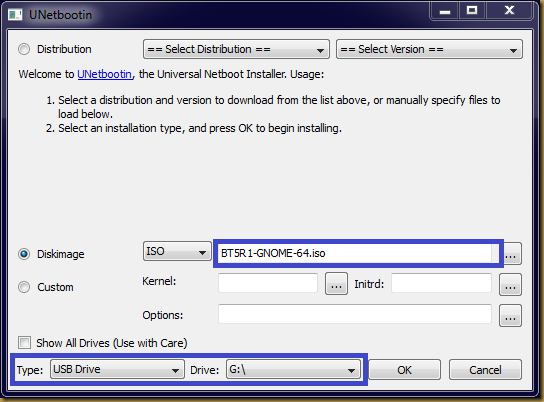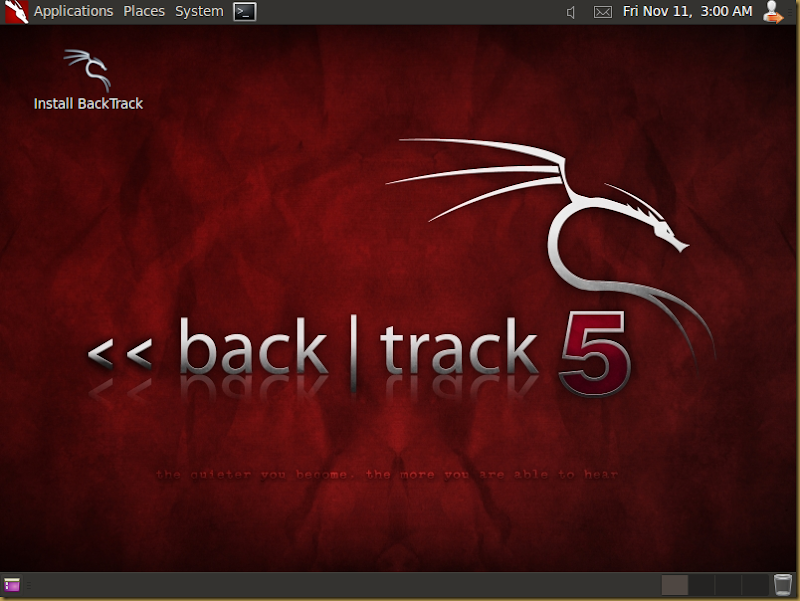BackTrack Linux is an operating system based on the Ubuntu GNU/Linux distribution aimed at digital forensics and penetration testing use.[8] It is named after backtracking, a search algorithm. For more information and download a copy of backtrack, visit http://www.backtrack-linux.org/
Boot BackTrack via USB Flash Drive
- The USB flash drive should have enough space to fit the BackTrack Linux ISO file
- Format USB flash drive to file system FAT32
- Download an utility UNetbootin (http://unetbootin.sourceforge.net/) to create a bootable Live USB.
- Launch UNetbootin and burn the iso file into USB flash drive.
- The following screen shows UNetbootin usage:

- Once done, configure machine to boot from USB storage, plug in USB flash drive and boot the machine
- BackTrack Linux should be ready to use after booting
Boot BackTrack via PXE
PXE booting is another interesting configuration that may boot system from network.
- Mount BackTrack ISO file to extract two files requires for PXE booting: initrd.gz and vmlinuz
-bash-4.1$ ls /mnt/iso/bt5/casper/ -al total 2030472 dr-xr-xr-x 2 root root 2048 Aug 18 13:37 . dr-xr-xr-x 6 root root 2048 Aug 18 13:48 .. -r--r--r-- 1 root root 46099 Aug 18 13:37 filesystem.manifest -r--r--r-- 1 root root 45951 Aug 18 13:37 filesystem.manifest-desktop -r--r--r-- 1 root root 10 Mar 6 2011 filesystem.size -r-xr-xr-x 1 root root 2023530496 Aug 18 13:48 filesystem.squashfs -r--r--r-- 1 root root 17036519 Aug 18 13:18 initrdf.gz -r--r--r-- 1 root root 17036173 Aug 18 13:18 initrd.gz -r--r--r-- 1 root root 17038433 Aug 18 13:18 initrds.gz -r--r--r-- 1 root root 200 Mar 6 2011 README.diskdefines -r--r--r-- 1 root root 4462512 Aug 18 13:18 vmlinuz
- Copy initrd.gz and vmlinuz to TFTP boot folder. The following shows BackTrack 4 and 5 TFTP boot folder:
-bash-4.1$ ls -gGal bt* bt4: total 12948 drwxr-xr-x 2 4096 Jul 22 13:35 . drwxr-xr-x 26 4096 Nov 3 17:15 .. -r--r--r-- 1 8555925 Jan 1 2010 initrd.gz -r--r--r-- 1 4690640 Dec 14 2009 vmlinuz bt5: total 21008 drwxr-xr-x 2 4096 Jul 23 07:43 . drwxr-xr-x 26 4096 Nov 3 17:15 .. -r--r--r-- 1 17036173 Oct 15 09:29 initrd.gz -r--r--r-- 1 4462512 Oct 15 09:29 vmlinuz
- Mount BackTrack ISO file and setup NFS access to the mount point.
- Configure PXE boot configuration file:
label BackTrack 4 menu label Backtrack Linux 4 kernel bt4/vmlinuz append initrd=bt4/initrd.gz BOOT=casper boot=casper nopersistent rw quite vga=0x317 netboot=nfs nfsroot=192.168.1.1:/mnt/bt4 label BackTrack 5 menu label Backtrack Linux 5 kernel bt5/vmlinuz append initrd=bt5/initrd.gz boot=casper text vga=791 netboot=nfs nfsroot=192.168.1.1:/mnt/bt5
- Configure machine to Boot from PXE and select BackTrack item to boot BackTrack Linux
Install BackTrack to Local Storage
- Boot BackTrack Linux and start GUI interface by typing “startx” in shell prompt:

- Double click “Install BackTrack” icon on the screen to start install BackTrack to local storage
Configure: Start DHCP client
Start ethernet adapter eth0 with DHCP client:
# dhclient eth0
Configure eth0 to act as DHCP client permanently:
# cat /etc/network/interfaces
auto lo
iface lo inet loopback
auto eth0
iface eth0 inet dhcp
Configure: Enable SSH
Generate SSH RSA key pair for first use:
# sshd-generate
To start ssh manually:
# service ssh start
Start SSH service when startup:
# update-rc.d -f ssh defaults
No comments:
Post a Comment